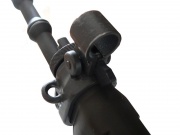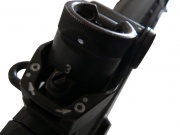Difference between revisions of "Sight"
(→Measuring instruments) |
m (1 revision) |
Latest revision as of 15:56, 15 March 2013


A sight is an optical device used to assist aim by guiding the eye and aligning it with a weapon or other item to be pointed. Various forms of sights exist, such as iron sights, red dot sights, peep sights, and telescopic sights. For aircraft use there are also reflector sights and gyro gunsights.
Sights are used in telescopes, firearms, artillery pieces, tank and aircraft weapons, and in various measuring instruments.
A theatrical followspot sight is used to aim the large spotlights used to follow the talent on stage during performances. They attach to the spotlight usually by magnets and are easily calibrated. They differ from rifle scopes in that they often provide zero magnification. The operator sees a red dot in the sight and "lays" it over the target to aim it.
Contents |
[edit] Telescope sights
Astronomical telescopes often have a low-power sight attached to the telescope tube. These are often in the form of a small telescope or a reflex sight. These permit the telescope user to find a celestial object without having to deal with the high magnification of the main telescope.
[edit] Aircraft gunsights
Aircraft have some of the most complex gunsights.
[edit] Gyro Gunsight
In WWII, early P-51Ds were equipped with simple N-9 sights used light projected onto a glass. Later models were fitted with the sophisticated K-14 computing sight. Gyroscopes and magnetic electrical fields in the box were used with consideration of the speed of the projectiles, and the target's speed and usual distance. Data was reflected in images reflected on the glass, effectively calculating the target deflection. The pilot had to set the wingspan of the target, and use a throttle mounted control to keep the target centered. This made the pilot's hunting much easier.[1]
[edit] Radar ranging gunsight
Korean war F-86 Sabres used radar to compute distance to the target, which proved as one of many decisive advantages to MiG-15s which in many ways were the equal or better of the American fighters, but lacked this technology. Supersonic fighters such as the F-100 and its successor, the F-105 Thunderchief also were fitted with this technology. Nearly all MiG kills of the F-105 were scored with these gunsights. Ironically, the F-4 Phantom which was tasked with MiG patrol after heavy F-105 losses lacked an internal gun, and even when fitted with a gun pod, also lacked a dogfighting gunsight. The ultimate USAF version, the F-4E was based on adding an internal gun and gunsight. The succeeding "teen" generation fighters were all built with an internal gun and radar ranging gunsight, usually integrated with a heads-up display.
[edit] Measuring instruments
Sights on measuring instruments vary greatly from simple slots to complex optical devices.